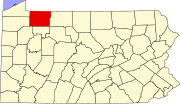Warren, Pennsylvania
Warren is a city in Warren County, Pennsylvania, United States. The population was 10,259 at the 2000 census. It is the county seat of Warren CountyTemplate:GR. It is home to the headquarters of the Allegheny National Forest and the Cornplanter State Forest. It is also the headquarters for the Chief Cornplanter Council, the oldest continuously chartered Boy Scouts of America Council.
History
Warren was initially inhabited by Native Americans of the Seneca nation. French explorers had claims to the area but control was transferred to the British after the French and Indian War. After the Revolutionary War, General William Irvine and Andrew Ellicott were sent to the area to lay out a town in 1795. The first permanent structure in Warren, a storehouse built by the Holland Land Company, was completed in 1796. Daniel McQuay of Ireland was the first permanent inhabitant of European descent. Lumber was the main industry from 1810–1840, as the abundance of wood and access to water made it profitable to float lumber down the Allegheny River to Pittsburgh.
David Beaty discovered oil in Warren in 1875 while drilling for natural gas in his wife's flower garden. Oil came to dominate the city's economy.
In recent years Warren has struggled through hard economic times, but the city is attempting to bounce back with the Impact Warren project, a riverfront development project in downtown Warren. The completed project will include new townhouses and senior citizen housing, new retail and commercial development, a parking garage, a convention center, and bus depot. This project, coupled with the new commercial development in North Warren, may help revive the economy of the city.

Major employers include the United Refining Company, who supplies Kwik Fill and Red Apple Food Mart gas stations, Allegheny National Forest, Northwest Savings Bank, Whirley-Drinkworks, Superior Tire and Rubber Corporation, Pennsylvania General Energy, Blair Corporation, and Interlectric.
Geography
Warren is located at 41°50′39″N 79°8′33″W / 41.84417°N 79.14250°WInvalid arguments have been passed to the {{#coordinates:}} function (41.844133, -79.142443)Template:GR. The city is located at the confluence of the Allegheny River and the Conewango Creek. The Conewango Creek flows between North Warren and Warren, and the Allegheny Reservoir and Kinzua Dam are situated nearby.
According to the United States Census Bureau, the city has a total area of 3.1 square miles (8.1 km²), of which, 2.9 square miles (7.6 km²) of it is land and 0.2 square miles (0.5 km²) of it (6.11%) is water.
Demographics
As of the censusTemplate:GR of 2000, there were 10,259 people, 4,565 households, and 2,606 families residing in the city. The population density was 3,508.3 people per square mile (1,356.5/km²). There were 5,046 housing units at an average density of 1,725.6/sq mi (667.2/km²). The racial makeup of the city was 98.53% White, 0.20% African American, 0.20% Native American, 0.36% Asian, 0.02% Pacific Islander, 0.13% from other races, and 0.56% from two or more races. Hispanic or Latino of any race were 0.39% of the population.
There were 4,566 households out of which 27.2% had children under the age of 18 living with them, 43.0% were married couples living together, 10.8% had a female householder with no husband present, and 42.9% were non-families. 37.6% of all households were made up of individuals and 16.4% had someone living alone who was 65 years of age or older. The average household size was 2.17 and the average family size was 2.87.
In the city the population was spread out with 23.1% under the age of 18, 7.0% from 18 to 24, 28.4% from 25 to 44, 23.4% from 45 to 64, and 18.1% who were 65 years of age or older. The median age was 39 years. For every 100 females there were 88.5 males. For every 100 females age 18 and over, there were 83.9 males.
The median income for a household in the city was $32,384, and the median income for a family was $41,986. Males had a median income of $32,049 versus $22,969 for females. The per capita income for the city was $18,272. About 8.0% of families and 10.7% of the population were below the poverty line, including 11.5% of those under age 18 and 6.0% of those age 65 or over.

